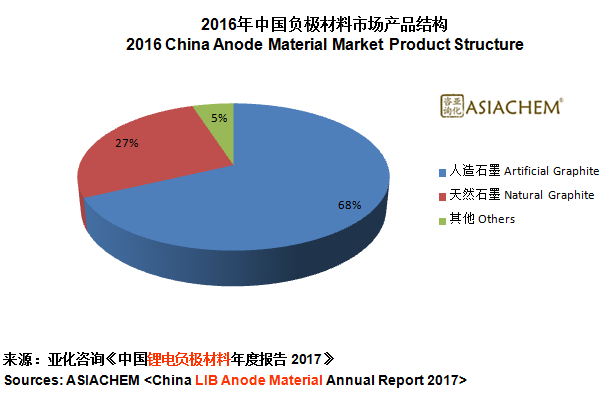In LIB anode materials, graphite becomes market mainstream because of its good cyclical stability, ideal charging / discharging platform and high cost performance. ASIACHEM <China LIB Anode Material Annual Report 2017> shows that, in 2016, China LIB anode material consumption was about 78.9kt, among, 95% are artificial graphite and natural graphite.

Research indicates that, power battery which used graphite anode material maximum monomer energy density is below 250Wh/kg. In Apr 2017, MIIT, NDRC and MOST printed and released ‘Vehicle Mid and Long Term Development Plan’, the ‘Plan’ points out, to 2020, power battery monomer specific energy reaches more than 300Wh/kg and tries its best to realize 350Wh/kg, system specific energy reaches more than 260Wh/kg. ASIACHEM believes that, R&D new type high energy density, high performance anode material is extremely urgent. Among, silicon based anode material has become LIB anode material factories and battery enterprises to improve and increase battery energy density’s best option.
Public information shows that, what Tesla Model 3 uses is silicon carbon anode material. Through adding 10% silicon based material to artificial graphite, its battery specific volume reaches more than 550mAh/g and energy density can reach 300Wh/kg.
Oct 2015, Maxell Co., subsidiary of Japan Hitachi that engages in battery manufacturing developed a new LIB which used SiO-C as anode material, and successfully applied to commercialized products like smart phones etc.
ASIACHEM <China LIB Anode Material Annual Report 2017> shows that, 2016-2017 China silicon based anode material R&D and production condition are as below.
BTR
In Jul 2017, BTR stated that, the company silicon carbon anode material R&D and production passed Samsung authentication in 2013; in 2016, the company silicon carbon anode material output and sales further increased.
In Nov 2016, Huizhou BTR Technology Park silicon carbon anode material project EIA 2nd publicity. The project plans to construct 3000t/a silicon carbon anode material project in BTR Huizhou Huiyang current factory. In Apr 2017, BTR stated that, this project EIA has not been approved yet.
In Apr 2016, BTR stated that, the company currently has 300t/a silicon carbon anode material capacity and 700t/a SiO-C anode material capacity.
Guoxuan High-tech
In May 2017, ‘High Specific Energy Power LIB R&D and Integrated Application’, which is led and undertaken by Hefei Guoxuan High-tech Power Energy gained stage progress.
Currently, monomer battery which uses high nickel cathode material and silicon based anode material realizes 281Wh/kg energy density, 1C rate charging / discharging room temperature cycling 350 times, volume remains 80%; monomer battery which uses Li-rich cathode material and silicon based anode material realizes 302Wh/kg energy density, 0.5C rate charging / discharging room temperature cycling 195 times, volume remains 80%.
In Nov 2016, Guoxuan High-tech released announcement, planned to raise no more than CNY 3.6bn funds in 10kt/a high nickel ternary material cathode material and 5000t/a silicon based composite material industrialization project.
Shanshan
In Jul 2017, Shanshan stated that, currently, the company silicon carbon anode material has started gradually to the limit of its capacity, according to energy density to make price and cost measurement is Wh. Before, in Apr 2017, the company stated that, the company is expected to complete 4000t/a silicon carbon anode material production size.
Shanshan 2017 H1 Semiannual Report shows that, in the report period, the company purchased 100% share of Huzhou Chuangya with CNY 240M. Before, in Mar 2017, HU Bo, GM of Huzhou Chuangya, stated that, the company silicon anode material energy density can reach 1300-1400mAh/g, silicon carbon anode material can reach 600mAh/g, and enter pilot scale production in H1, 2017.
Putailai
In Apr 2017, Shanghai Putailai LIB material project commencement ceremony was held in Liyang, Jiangsu. The project mainly includes new type silicon carbon composite anode material which cooperation and mass production with Institute of Physics, CAS. Project planned to total invest CNY 5bn, and estimated to partly completion and operation by the end of 2017.
Shenzhen Sino Technology
In May 2016, BAO Haiyou, GM of Shenzhen Sino, stated that, multi-pole silicon / carbon anode material which independently R&D by the company, first time efficiency ≥95%, 900 cycles material volume ≥1000mAh/g.
ASIACHEM <China LIB Anode Material Annual Report 2017> believes that, although there are some LIB on market which used silicon based material as anode material realized commercialized, large scale industrial application of silicon based anode material still has technology etc. problems need to be solved. In the future, considering national policies and markets to LIB energy density requirement’s continue increasing, silicon based material R&D and production will further accelerating. ASIACHEM database shows that, if Huizhou BTR project been approved, by the year 2019, China LIB anode material capacity will reach 335kt/a, among, silicon based anode material capacity will reach 10kt/a, occupies 3.9%.